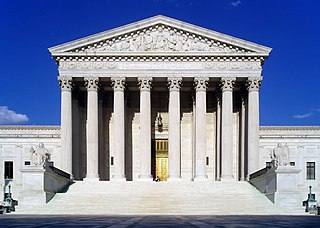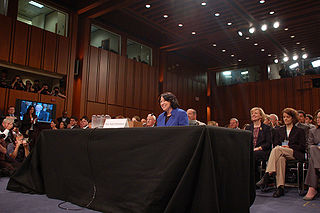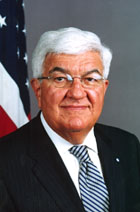
Speculation abounded over potential nominations to the Supreme Court of the United States by President George W. Bush since before his presidency.

Miguel Angel Estrada Castañeda is a Honduran-American attorney who became embroiled in controversy following his 2001 nomination by President George W. Bush to the United States Court of Appeals for the District of Columbia Circuit. Senate Democrats, unable to block his nomination in the Senate Judiciary Committee after the Republican Party took control of the U.S. Senate in 2002, used a filibuster for the first time to prevent his nomination from being given a final confirmation vote by the full Senate.

Elena Kagan is an American lawyer who serves as an associate justice of the Supreme Court of the United States. She was nominated by President Barack Obama on May 10, 2010, and has served since August 7, 2010. Kagan is the fourth woman to become a member of the Court.

Sonia Maria Sotomayor is an American lawyer and jurist who serves as an associate justice of the Supreme Court of the United States. She was nominated by President Barack Obama on May 26, 2009, and has served since August 8, 2009. She is the third woman, first woman of color, the first Hispanic, and first Latina to serve on the Supreme Court.

The demographics of the Supreme Court of the United States encompass the gender, ethnicity, and religious, geographic, and economic backgrounds of the 116 people who have been appointed and confirmed as justices to the Supreme Court. Some of these characteristics have been raised as an issue since the court was established in 1789. For its first 180 years, justices were almost always white male Protestants of Anglo or Northwestern European descent.

President Barack Obama made two successful appointments to the Supreme Court of the United States. The first was Judge Sonia Sotomayor to fill the vacancy created by the retirement of Justice David H. Souter. Sotomayor was confirmed by the United States Senate on August 6, 2009, by a vote of 68–31. The second appointment was that of Solicitor General Elena Kagan to replace the retired John Paul Stevens. Kagan was confirmed by the Senate on August 5, 2010, by a vote of 63–37.
Speculation abounded over potential nominations to the Supreme Court of the United States by Ronald Reagan even before his presidency officially began, due to the advanced ages of several justices, and Reagan's own highlighting of Supreme Court nominations as a campaign issue. Reagan had promised "to appoint only those opposed to abortion and the 'judicial activism' of the Warren and Burger Courts". Conversely, some opposed to Reagan argued that he could "appoint as many as five Justices" and would "use the opportunity to stack the Court against women, minorities and social justice".

On May 26, 2009, President Barack Obama announced his selection of Judge Sonia Sotomayor for Associate Justice of the Supreme Court of the United States, to replace retiring Justice David Souter. Sotomayor's nomination was submitted to the United States Senate on June 1, 2009, when the 111th Congress reconvened after its Memorial Day recess. Sotomayor was confirmed by the U.S. Senate on August 6, 2009 by a 68–31 vote, and was sworn in by Chief Justice John Roberts on August 8, 2009, becoming the first Hispanic to serve on the Supreme Court.

The nomination and confirmation of justices to the Supreme Court of the United States involves several steps, the framework for which is set forth in the United States Constitution. Specifically, Article II, Section 2, Clause 2, provides that the president of the United States nominates a justice and that the United States Senate provides advice and consent before the person is formally appointed to the Court. It also empowers a president to temporarily, under certain circumstances, fill a Supreme Court vacancy by means of a recess appointment. The Constitution does not set any qualifications for service as a justice, thus the president may nominate any individual to serve on the Court.

On May 10, 2010, President Barack Obama announced his selection of Elena Kagan for Associate Justice of the Supreme Court of the United States, to replace retiring Justice John Paul Stevens. Kagan's nomination was confirmed by a 63–37 vote of the United States Senate on August 5, 2010. When nominated, Kagan was Solicitor General of the United States, a position to which Obama had appointed her in March 2009. Kagan was the first Supreme Court nominee since Sandra Day O'Connor in 1981 to not be a sitting circuit court judge and the most recent such nominee as of 2023. She was the first Supreme Court nominee since William Rehnquist and Lewis F. Powell Jr. in 1971 to not be a sitting judge on any court.

On March 16, 2016, President Barack Obama nominated Merrick Garland for Associate Justice of the Supreme Court of the United States to succeed Antonin Scalia, who had died one month earlier. At the time of his nomination, Garland was the Chief Judge of the United States Court of Appeals for the District of Columbia Circuit.

On July 9, 2018, President Donald Trump nominated Brett Kavanaugh for Associate Justice of the Supreme Court of the United States to succeed retiring Justice Anthony Kennedy. When nominated, Kavanaugh was a judge of the United States Court of Appeals for the District of Columbia Circuit, a position he was appointed to in 2006 by President George W. Bush.

Mount Everest in 2018 is about events in the year about the highest Earth mountain, Mount Everest, a popular mountaineering tourism and science destination in the 2010s. In 2018, 807 climbers summited Mount Everest, which is a popular mountaineering goal. This year is noted for an especially long weather window of 11 days straight of calm, which reduced crowding at the high base camps. With over 800 reaching the top, it was the highest amount ever to reach the top in recorded history, besting the previous year by over 150 summitings.

On February 25, 2022, President Joe Biden announced that he would nominate Ketanji Brown Jackson to the position of associate justice of the Supreme Court of the United States to fill the vacancy by Stephen Breyer, who announced his retirement on January 27, 2022, at the age of 83. Jackson, a former law clerk of Breyer, was a judge on the United States Court of Appeals for the District of Columbia Circuit, having been appointed by Biden in 2021. Jackson is the first Black woman in U.S. history to be nominated to serve on the U.S. Supreme Court.
Harlan F. Stone was nominated and confirmed twice to the Supreme Court of the United States. First in 1925, when President Calvin Coolidge nominated him to serve as an associate justice and again in 1941, when President Franklin D. Roosevelt nominated Justice Stone to be elevated to Chief Justice. Both times, the United States Senate confirmed the nominations.

Sherman Minton was nominated to serve as an associate justice of the Supreme Court of the United States by U.S. President Harry S. Truman on September 14, 1949 after the death in office of Wiley Rutledge created a vacancy on the Supreme Court. Per the Constitution of the United States, Minton's nomination was subject to the advice and consent of the United States Senate, which holds the determinant power to confirm or reject nominations to the U.S. Supreme Court. The nomination was met with a mixed reception and faced active opposition stemming both from the belief that Minton would be a liberal justice and from his history as a New Deal-supporting member of the United States Senate. There was an unsuccessful effort to compel Minton to testify before the United States Senate Committee on the Judiciary. Nevertheless, the nomination was approved by a 48-16 vote of the United States Senate on October 4, 1949.

Since the creation of the Senate Committee on the Judiciary in 1816, many, but not all, nominations for the Supreme Court of the United States have been first referred to a committee for review prior to facing a confirmation vote before the full United States Senate. Some nominations have been withdrawn, lapsed, or been postponed without being referred to the Judiciary Committee, while some others up until 1941 had proceeded to full Senate confirmation votes without first being reviewed by the Judiciary Committee. However, ever since 1941, all nominations have been referred to the Judiciary Committee.














